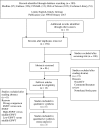High-energy versus low-energy extracorporeal shock wave therapy for calcifying tendinitis of the shoulder: which is superior? A meta-analysis
- PMID: 24872197
- PMCID: PMC4117900
- DOI: 10.1007/s11999-014-3680-0
High-energy versus low-energy extracorporeal shock wave therapy for calcifying tendinitis of the shoulder: which is superior? A meta-analysis
Abstract
Background: There are several treatment options for calcifying tendinitis of the shoulder. The next step treatment after conservative treatment fails is still a matter of dispute. Extracorporeal shock wave therapy (ESWT) has been shown to be a good alternative to surgery, but the best treatment intensity remains unknown. High-energy ESWT is much more painful, more expensive, and usually is done in an inpatient setting, whereas low-energy ESWT can be performed in an outpatient setting by a physical therapist.
Questions/purposes: A systematic review and meta-analysis of randomized trials was performed to answer two clear research questions: (1) Is there a greater increase in the Constant-Murley score in patients treated with high-energy ESWT compared with those treated with low-energy ESWT by 3 months and by 6 months? (2) Is there a greater chance of complete resorption of the calcifications in patients treated with high-energy ESWT compared with those treated with low-energy ESWT by 3 months and by 6 months?
Methods: Five relevant electronic online databases, Medline (through PubMed), EMBASE (through OVID), Cinahl (through EBSCO), Web of Science, and the Cochrane Central Register of Controlled Trials, were systematically searched. We also crosschecked the reference lists of articles and reviews for possible relevant studies. Eligible for inclusion were all randomized controlled trials (RCTs) that compared high-energy ESWT (> 0.28 mJ/mm(2)) with low-energy ESWT (< 0.08 mJ/mm(2)). One author examined titles and abstracts of each identified study to assess study eligibility. Two reviewers independently extracted data and assessed the risk of bias and study quality. The primary outcome measure, the Constant-Murley score, was assessed by comparing mean functional outcome scores between the groups. Secondary outcomes were assessed using odds ratios, when appropriate data were pooled. Based on this process, five RCTs (359 participants) were included.
Results: All five RCTs showed greater improvement in functional outcome (Constant-Murley score) in patients treated with high-energy ESWT compared with patients treated with low-energy ESWT at 3 and 6 months. The 3-month mean difference was 9.88 (95% CI, 9.04-10.72, p < 0.001; 6-month data could not be pooled). Furthermore, high-energy ESWT more often resulted in complete resorption of the deposits at 3 months. The corresponding odds ratio was 3.40 (95% CI, 1.35-8.58) and p = 0.009 (6-month data could not be pooled).
Conclusion: When shock wave therapy is chosen, high-energy shock wave therapy is more likely to result in improved Constant-Murley score and resorption of the deposits compared with low-energy therapy.
Level of evidence: Level I, therapeutic study. See the Instructions for Authors for a complete description of levels of evidence.
Figures







References
Publication types
MeSH terms
LinkOut - more resources
Full Text Sources
Other Literature Sources
Medical
Molecular Biology Databases
Research Materials

